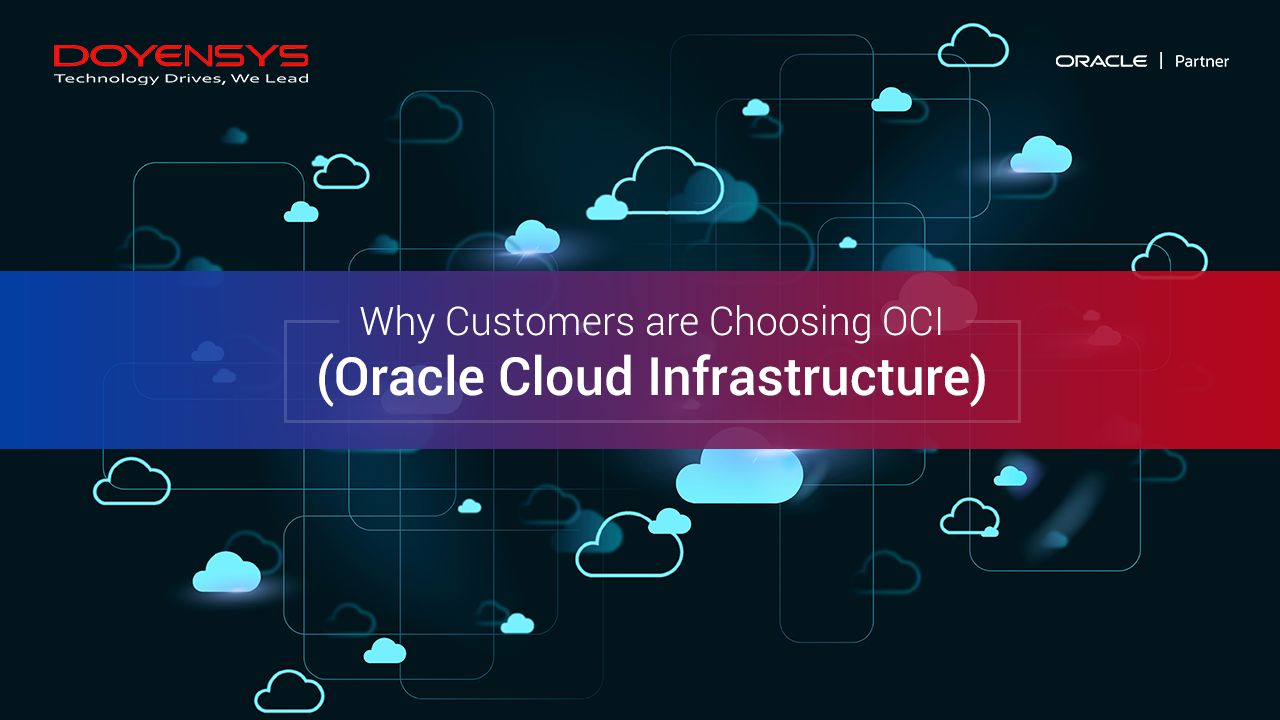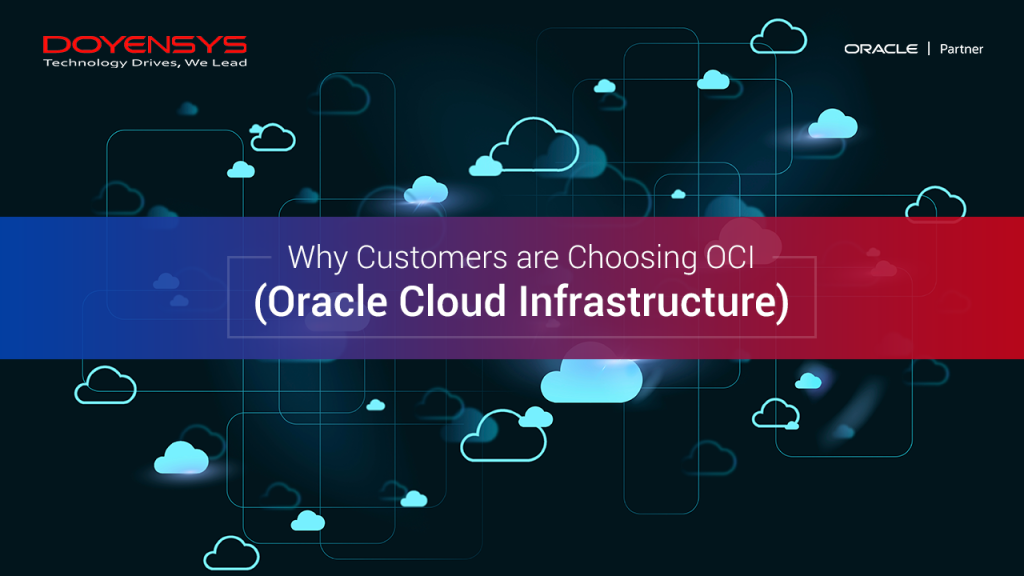
Cloud computing has grown at an exponential rate over the past decade. The cloud computing market is now greater than it has ever been. Because of the COVID-19 epidemic, digital transformation has accelerated, making cloud computing a top priority.
Naturally, the cloud computing business has emerged several players who now dominate the landscape. Amazon Web Services, Microsoft Azure, Google Cloud, Alibaba Cloud, and Oracle Cloud are the clear market leaders in Gartner’s 2021 Magic Quadrant for Public Cloud Infrastructure Professional and Managed Services.
Despite not being the most popular hosted platform, Oracle Cloud Infrastructure provides considerable benefits to users, which is why customers prefer OCI to others.
 What is OCI?
What is OCI?
Oracle Cloud is the 1st open cloud that was created from scratch that turns out to be a superior cloud for every app. Oracle Cloud, which debuted at the end of 2016, is one of the newest entrants in the field.
Oracle made solutions that answer difficulties that customers have with existing public clouds by rethinking core engineering and systems design for cloud computing. OCI helps businesses migrate existing enterprise workloads faster, improves application reliability and performance, and provides the resources they need to build creative cloud applications.
Furthermore, Oracle Cloud includes built-in identity management capabilities. It also offers safe integration for its numerous services, customer applications, and cloud services from other cloud providers.
Why choose OCI over others?
Oracle’s cloud environment is designed with one of its major aims in mind: its current user base. Almost all of the users are on-premises. Oracle has created tools to help users move to the cloud on this understanding.
They also have a solid support system in place for hybrid clouds. There are six primary reasons customers choose Oracle Cloud Infrastructure (OCI) for all their cloud workloads based on the features presented by OCI.
It’s a lot easier to move mission-critical enterprise workloads:
Because most hyper-scale cloud providers were built on a virtual machine model with resources shared through the compute hypervisor and overcrowded networks, many enterprise applications are difficult to migrate to the cloud. This ancient cloud computing architecture makes it impossible for enterprise applications to work as intended without major modification, adding complexity and uncertainty.
Scale-up designs for resource scaling, ultra-low-latency networks; permanent connections to relational databases; and resource clustering for availability were designed to run optimally on enterprise and other performance-sensitive on-premises applications. To meet the needs of enterprise applications, OCI was built with important cloud technologies.
Moreover, only Oracle Platform offers a cloud-based Oracle database with Exadata and Rack that can handle millions of transactions per second. Customers will be able to utilize the applications with little latency and no downtime due to this. It guarantees high availability for databases with hundreds of terabytes of storage.
OCI offers superior price-performance:
Choosing the cloud is frequently focused on cost, and OCI is a market leader in client value. Oracle kept its prices competitive by not requiring consumers to commit to long-term contracts. They built fundamental cloud capabilities like security and container management into the compute cost rather than charging extra.
They improved network performance while pricing data transfer out of the cloud to reflect how companies construct multi-cloud networks to serve their consumers.
OCI brings maximum support for hybrid cloud strategies:
Oracle Cloud’s architecture was designed to allow clients to choose from various deployment choices. Customers can run a whole OCI region from their own data center, migrate entire on-premises VMware systems to public cloud regions, or deliver OCI services like Exadata and Roving Edge to the exact location where the work is needed.
Oracle’s unique connectivity with Microsoft Azure allows it to provide low-latency, unified identity, and multi-cloud services in 11 different countries. Customers can update their organization with the control, performance, and value of OCI’s hybrid options, whether they have already chosen a major cloud provider or are still in the early stages of cloud adoption.
Autonomous services do all:
Oracle may have been late to the cloud party, but they’re ahead of the pack when it comes to cloud-based AI and machine learning. Oracle Autonomous Database Cloud eliminates errors, lowers costs, improves security, and is 100 times more dependable than on-premises Oracle Solutions.
Oracle Engineered Systems, a hybrid of Oracle hardware and software, self-tunes and optimizes your Oracle workloads to make them more cost-effective and efficient. Autonomous services are intended to automate the operating system and database patching and performance tweaking.
They also aim to lessen the risk and cost associated with human errors. Oracle’s big data offerings have become trustworthy and extremely useful as a result of their careful attention to identifying and harnessing only the most relevant, valuable data for their enterprise customers – and the value they deliver with their big data is yet another reason customers are choosing the Oracle Cloud over its competitors.
Your apps, your way:
Building a future-proof platform necessitates utmost flexibility and control. You may create the applications your organization need by using a fully integrated application development platform. While OCI is meant to make business applications more performant, resilient, and scalable, cloud-native apps benefit from the same networking, compute, and storage advances.
OCI includes the cloud services and partner ecosystem you’ll need to create production-ready cloud-native apps. It all boils down to Oracle’s “New Era of Choice,” in which enterprise clients have the flexibility to migrate to the cloud on their timetables, at their speed, and without being pushed.
OCI provides default security:
Oracle didn’t just upgrade the architecture when constructing the next-generation cloud; they also improved essential qualities like security. Apps are constructed in most public clouds. Then security is bolted to the application and the services that operate it as they grow larger and more functional.
Each app users want to secure will necessitate several different services, each with its pricing. At OCI, they’ve built security into the core experience from the beginning of the application build or migration. They have developed most of their security tooling available to customers for free as part of their environment.
Final Words:
If you’re interested in learning more about Oracle Cloud as a solution for your agency or organization, Doyensys Cloud service provider is a great place to start. We’ll guide and collaborate with you to find the best cloud solution for your needs, budget, and unique environment or security requirements.
